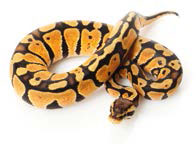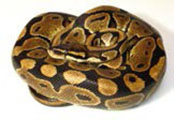The aim of this article is to start by providing a basic practical guide to the subject of ball python genetics, illustrating the theory with ‘real life’ examples.
The three cases which are the subject of this article are:
■ Co-dominant
■ Dominant
■ Simple recessive
Firstly, a python morph is said to be dominant if there is no visual difference in colour or pattern between homozygous and heterozygous morphs.
Now you’re asking yourself what is homozygous and heterozygous! Let’s take a pied ball python for example. It is described as homozygous because it received two pied genes - one from its mother and the other from its father. A het (heterozygous) pied will contain one and only one pied gene from either the father or mother. Since it received only one pied gene, it will not look pied in this case (unlike a homozygous pied) but it will contain a gene for the pied trait. The heterozygote will resemble an ordinary normal (wild type) ball python in appearance.
Co-dominant
If you breed the co-dominant pastel to a co-dominant pastel, the anticipated results will be:-
This is because some traits will express themselves visually even in the first generation as heterozygous.

50% pastel
When two of these visual heterozygous offspring are bred together, a “super” version is produced.

25% normal